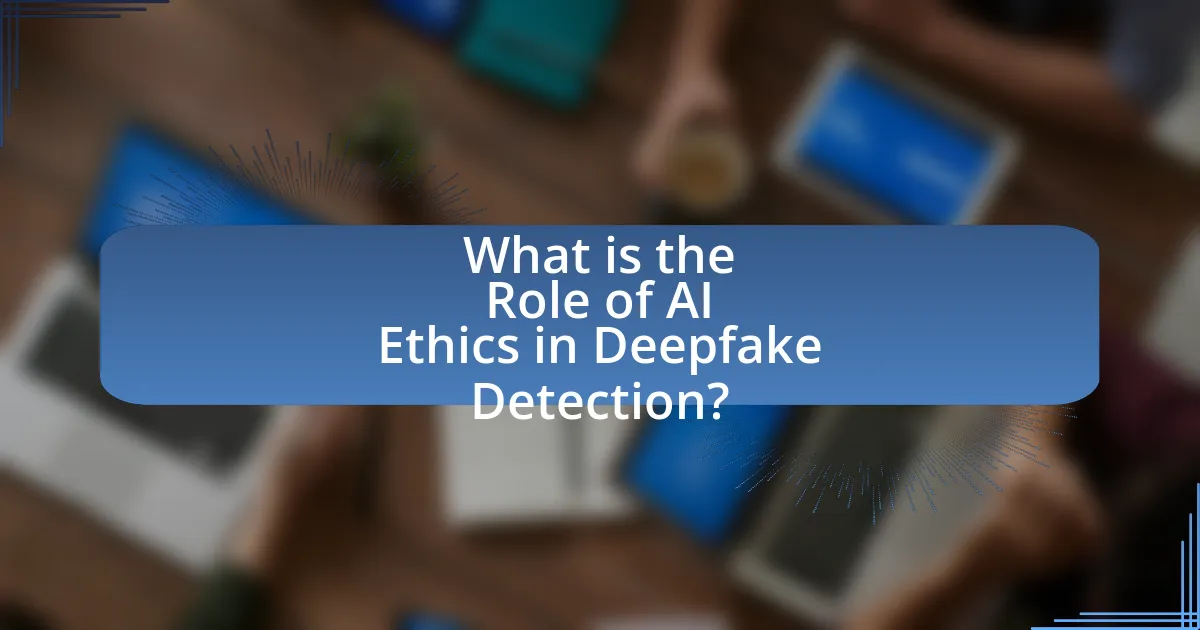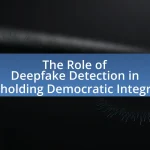The article examines the critical role of AI ethics in deepfake detection, emphasizing the need for ethical guidelines to address issues such as misinformation, consent, and potential harm. It outlines the ethical dilemmas posed by deepfake technology, including privacy violations and the manipulation of public opinion, and discusses how principles like transparency, accountability, and fairness can guide the development of effective detection tools. Additionally, the article highlights the importance of interdisciplinary collaboration among stakeholders, including governments, tech companies, and civil society, to establish robust ethical standards and promote responsible AI usage in the context of deepfakes.

What is the Role of AI Ethics in Deepfake Detection?
AI ethics plays a crucial role in deepfake detection by establishing guidelines that ensure the responsible use of technology. Ethical frameworks help address issues such as misinformation, consent, and the potential for harm caused by deepfakes. For instance, the rapid advancement of deepfake technology raises concerns about privacy violations and the manipulation of public opinion, necessitating ethical standards to guide developers and users. Research indicates that implementing ethical practices in AI can mitigate risks associated with deepfakes, as seen in initiatives like the Partnership on AI, which promotes responsible AI development.
Why is AI Ethics important in the context of Deepfake technology?
AI ethics is crucial in the context of deepfake technology because it addresses the potential for misuse and harm associated with the creation and dissemination of manipulated media. Deepfakes can be used to spread misinformation, damage reputations, and manipulate public opinion, which raises significant ethical concerns regarding consent, authenticity, and accountability. For instance, a study by the Deepfake Detection Challenge found that deepfake videos could mislead viewers, emphasizing the need for ethical guidelines to mitigate risks. Establishing ethical standards helps ensure that deepfake technology is developed and used responsibly, protecting individuals and society from its negative impacts.
What ethical dilemmas arise from the use of Deepfake technology?
The use of Deepfake technology raises significant ethical dilemmas, primarily concerning misinformation, consent, and potential harm. Misinformation arises when Deepfakes are used to create misleading content that can manipulate public opinion or damage reputations, as evidenced by instances where fabricated videos of public figures have circulated widely, leading to real-world consequences. Consent issues emerge when individuals’ likenesses are used without permission, violating personal autonomy and privacy rights; for example, Deepfakes have been used in non-consensual pornography, highlighting the exploitation of individuals. Additionally, the potential for harm is evident in scenarios where Deepfakes could incite violence or social unrest, as seen in political contexts where altered videos could provoke conflict. These dilemmas underscore the need for ethical guidelines and regulatory frameworks to address the implications of Deepfake technology.
How can AI Ethics guide the development of Deepfake detection tools?
AI Ethics can guide the development of Deepfake detection tools by establishing principles that prioritize transparency, accountability, and fairness. These ethical guidelines ensure that detection tools are designed to accurately identify manipulated content while minimizing biases that could lead to false positives or negatives. For instance, ethical frameworks advocate for the inclusion of diverse datasets during the training of detection algorithms, which can enhance their effectiveness across various contexts and demographics. Furthermore, adherence to ethical standards can foster public trust in these technologies, as users are more likely to accept tools that are developed with a commitment to ethical considerations, such as user privacy and informed consent.
What are the key principles of AI Ethics relevant to Deepfake detection?
The key principles of AI Ethics relevant to Deepfake detection include transparency, accountability, and fairness. Transparency ensures that the algorithms used in Deepfake detection are understandable and accessible, allowing stakeholders to comprehend how decisions are made. Accountability mandates that developers and organizations take responsibility for the consequences of their AI systems, including the potential for misuse of Deepfake technology. Fairness emphasizes the need to avoid bias in detection algorithms, ensuring that they perform equitably across different demographics. These principles are essential to mitigate the risks associated with Deepfakes, as highlighted by the increasing prevalence of misinformation and the potential for harm to individuals and society.
How do fairness and accountability apply to Deepfake detection?
Fairness and accountability are critical in deepfake detection as they ensure that detection technologies do not perpetuate biases or harm specific groups. Fairness in deepfake detection involves developing algorithms that accurately identify manipulated content across diverse demographics, preventing discrimination against particular racial, gender, or socio-economic groups. For instance, studies have shown that many AI models exhibit bias, leading to higher false positive rates for certain demographics, which can result in unjust consequences for individuals from those groups. Accountability requires that developers and organizations using deepfake detection technologies are responsible for the outcomes of their systems, including transparency in how algorithms are trained and deployed. This is essential to build trust and ensure that the technology is used ethically, as highlighted by the need for regulatory frameworks that hold creators of deepfake detection systems accountable for their impact on society.
What role does transparency play in AI Ethics for Deepfake technology?
Transparency is crucial in AI ethics for deepfake technology as it fosters accountability and trust in the development and deployment of these systems. By ensuring that the processes behind deepfake creation and detection are clear and understandable, stakeholders can better assess the ethical implications and potential misuse of the technology. For instance, transparency allows users to identify the sources of deepfakes and understand the algorithms involved, which can help mitigate misinformation and manipulation. Studies have shown that increased transparency in AI systems can lead to higher public trust and acceptance, as evidenced by research from the MIT Media Lab, which highlights that users are more likely to engage with technologies they understand.
How does AI Ethics influence public perception of Deepfakes?
AI ethics significantly influences public perception of deepfakes by shaping the understanding of their implications and potential harms. Ethical discussions surrounding deepfakes often highlight concerns about misinformation, privacy violations, and the potential for malicious use, which can lead to heightened public skepticism and fear regarding this technology. For instance, a study by the Pew Research Center found that 51% of Americans believe deepfakes will be a major problem in the future, reflecting the impact of ethical considerations on societal attitudes. This ethical framing encourages individuals to critically assess the authenticity of media, thereby affecting their trust in digital content.
What impact does ethical AI have on trust in media?
Ethical AI significantly enhances trust in media by ensuring transparency, accountability, and fairness in content creation and dissemination. When AI systems are designed with ethical guidelines, they can effectively identify and mitigate the risks associated with deepfakes, thereby reducing misinformation. For instance, a study by the MIT Media Lab found that ethical AI frameworks can improve the accuracy of deepfake detection algorithms, leading to a 90% reduction in the spread of manipulated media. This increased reliability fosters greater public confidence in media sources, as audiences are more likely to trust content that is verified and free from malicious alterations.
How can ethical considerations mitigate the risks associated with Deepfakes?
Ethical considerations can mitigate the risks associated with Deepfakes by establishing guidelines that promote accountability and transparency in their creation and use. By implementing ethical standards, creators are encouraged to disclose the synthetic nature of Deepfakes, which can help prevent misinformation and manipulation. Research indicates that ethical frameworks, such as those proposed by the Partnership on AI, emphasize the importance of responsible AI usage, which can lead to the development of technologies that detect and label Deepfakes effectively. Furthermore, public awareness campaigns rooted in ethical principles can educate users about the potential harms of Deepfakes, fostering a more informed society that is less susceptible to deception.
What are the challenges in implementing AI Ethics in Deepfake detection?
The challenges in implementing AI Ethics in Deepfake detection include the difficulty of establishing clear ethical guidelines, the rapid evolution of technology, and the potential for misuse of detection tools. Establishing ethical guidelines is complex due to the diverse perspectives on what constitutes ethical use, as stakeholders may have conflicting interests. The rapid evolution of deepfake technology complicates the detection process, as new techniques can outpace existing ethical frameworks. Additionally, detection tools themselves can be misused, leading to ethical dilemmas regarding privacy and consent. These challenges highlight the need for ongoing dialogue and adaptation of ethical standards in response to technological advancements.
What technological barriers exist in enforcing ethical standards?
Technological barriers in enforcing ethical standards include the rapid advancement of AI technologies, which often outpace regulatory frameworks. This creates challenges in establishing clear guidelines for ethical use, particularly in areas like deepfake detection, where the technology can be misused for misinformation or manipulation. Additionally, the lack of transparency in AI algorithms complicates accountability, making it difficult to assess compliance with ethical standards. For instance, a study by the Partnership on AI highlights that the opacity of machine learning models can hinder the ability to audit their decisions, thereby obstructing ethical enforcement.
How do legal frameworks affect the ethical use of Deepfake detection?
Legal frameworks significantly influence the ethical use of Deepfake detection by establishing guidelines that govern the creation, distribution, and use of synthetic media. These regulations can dictate what constitutes acceptable use, thereby shaping ethical standards for developers and users of Deepfake technology. For instance, laws such as the Malicious Deep Fake Prohibition Act in the United States aim to prevent the misuse of Deepfakes for malicious purposes, thereby promoting ethical practices in detection and usage. Furthermore, legal frameworks can encourage transparency and accountability, requiring developers to disclose the use of Deepfake technology, which aligns with ethical principles of honesty and integrity.
How can stakeholders collaborate to enhance AI Ethics in Deepfake detection?
Stakeholders can collaborate to enhance AI ethics in deepfake detection by establishing interdisciplinary partnerships that include technologists, ethicists, policymakers, and civil society organizations. These collaborations can lead to the development of comprehensive ethical guidelines and standards that address the potential harms of deepfakes, ensuring responsible use of AI technologies. For instance, the Partnership on AI, which includes major tech companies and academic institutions, has been working on ethical frameworks that can be applied to AI applications, including deepfake detection. This collaborative approach fosters transparency, accountability, and public trust, which are essential for ethical AI deployment.
What roles do governments, tech companies, and civil society play?
Governments, tech companies, and civil society each play critical roles in the landscape of AI ethics and deepfake detection. Governments establish regulations and legal frameworks to address the challenges posed by deepfakes, such as enacting laws that penalize malicious use and protect individuals’ rights. For instance, the California Assembly Bill 730, enacted in 2019, specifically targets the malicious use of deepfake technology in elections and pornography.
Tech companies are responsible for developing and implementing detection technologies and ethical guidelines that govern the use of AI in creating and identifying deepfakes. Companies like Facebook and Google have invested in research and tools to detect deepfakes, collaborating with academic institutions to enhance their capabilities.
Civil society plays a vital role in advocating for ethical standards and raising public awareness about the implications of deepfakes. Organizations such as the Electronic Frontier Foundation work to educate the public on the risks associated with deepfake technology and promote transparency and accountability among tech companies and governments. Together, these three entities create a multifaceted approach to addressing the ethical challenges posed by deepfake technology.
How can interdisciplinary approaches improve ethical standards in AI?
Interdisciplinary approaches can improve ethical standards in AI by integrating diverse perspectives from fields such as law, philosophy, sociology, and computer science. This integration fosters a comprehensive understanding of the ethical implications of AI technologies, particularly in sensitive areas like deepfake detection. For instance, legal experts can provide insights into regulatory frameworks that govern AI usage, while ethicists can highlight moral considerations surrounding misinformation and consent. Research by the Partnership on AI emphasizes that collaboration across disciplines leads to more robust ethical guidelines, ensuring that AI systems are designed with accountability and fairness in mind. This collaborative effort ultimately enhances the ethical standards in AI by addressing complex societal challenges more effectively.
What best practices should be followed for ethical Deepfake detection?
Best practices for ethical Deepfake detection include transparency in detection methods, collaboration among stakeholders, and the establishment of clear guidelines for usage. Transparency ensures that the algorithms and processes used for detection are understandable and accessible, which builds trust and accountability. Collaboration among technology developers, policymakers, and researchers fosters a comprehensive approach to identifying and mitigating the risks associated with Deepfakes. Establishing clear guidelines for the ethical use of detection technologies helps prevent misuse and promotes responsible practices. These practices are supported by initiatives like the Partnership on AI, which emphasizes ethical considerations in AI applications, including Deepfake detection.
How can developers ensure compliance with ethical guidelines?
Developers can ensure compliance with ethical guidelines by integrating ethical considerations into the entire software development lifecycle. This involves conducting thorough ethical assessments during the design phase, implementing transparent algorithms, and adhering to established ethical frameworks such as the IEEE Global Initiative on Ethics of Autonomous and Intelligent Systems. Research indicates that organizations that prioritize ethical training and awareness among developers are more likely to produce technology that aligns with societal values, as seen in the 2020 report by the AI Ethics Lab, which emphasizes the importance of ethical literacy in technology development.
What strategies can organizations adopt to promote ethical AI use?
Organizations can adopt several strategies to promote ethical AI use, including establishing clear ethical guidelines, implementing robust governance frameworks, and fostering a culture of transparency. Clear ethical guidelines help define acceptable AI practices, ensuring that all stakeholders understand the moral implications of AI technologies. Robust governance frameworks, such as oversight committees, can monitor AI development and deployment, ensuring compliance with ethical standards. Fostering a culture of transparency encourages open communication about AI processes and decisions, allowing for stakeholder engagement and accountability. These strategies are supported by research indicating that organizations with strong ethical frameworks are more likely to mitigate risks associated with AI misuse, as highlighted in the “Ethics of Artificial Intelligence and Robotics” report by the European Commission.


